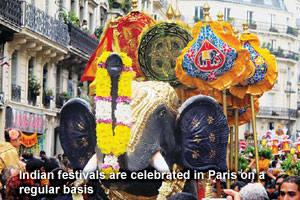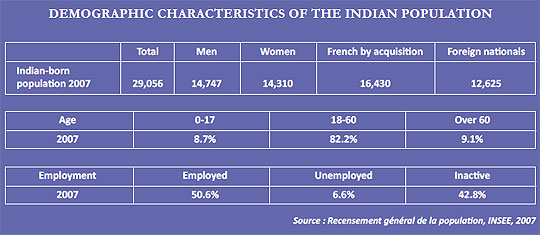|
Abstract
Indian migration in France is remarkable for its diversity and social invisibility.
Indian migrants belong to a wide spectrum of religious, ethnic, linguistic and social backgrounds and their migration routes to France are multiple: one can roughly distinguish between French speaking groups linked to France by the colonial past and more recent migrants from Punjab and Gujarat who ended in France because they could not migrate to the UK. Unskilled labour predominates among the first generation of non-French speaking migrants, but the second generation, supplemented by highly qualified professionals from India, started entering the job-market with qualifications. Few in numbers, Indians tend also to be invisible as migrants for the general public and in academic research—the later traditionally focusing on former colonised migrants. India benefits from a good image in France, and Indians tend to be considered as a model minority.
Introduction
A recent and little studied phenomenon, Indian migration to France is unique in its diversity. It includes both direct migrants from India and twice-migrants from the Indian Ocean, French-speaking Indians from the former French colonial possession Pondicherry and Indians with no historical or cultural connections to their host country. Some migrants are highly skilled the majority are, meanwhile, unskilled labour. Because of a traditional focus on former colonial migrants from Africa or Southern Europe, Indian migrants in France have been under-studied and correspondingly, they tend to be invisible in the collective imagination. This invisibility also has political advantages in a context where migrants have faced increasing stigmatisation. Economically successful, Indian migrants see themselves as a model minority, and they benefit from the good reputation of their home country. The term “Indian” refers to a socio-historical construct that covers more ground than is commonly understood. Besides direct migrants from India, it includes migrants of Indian origin who were born in the Indian Ocean Islands (Mauritius, La Réunion, Madagascar), in the West Indies (Martinique and Guadeloupe) and in South East Asia (Cambodia and Vietnam).
Moreover, “Indian” and “Hindu” are frequently used interchangeably in contemporary French popular usage, and they often refer to South Asians who are neither Indians nor Hindus (such as Pakistanis and Bangladeshis). This terminological fuzziness contributes to the lack of social awareness about these unknown minority groups.
A brief history of Indian migration to France
 Indian migration to France is a centuries-old phenomenon: indeed, as early as the seventeenth century, a few lascars (seamen) and ayahs (domestic helps) found their way to France. Later in the nineteenth century, Paris became a fashionable destination for Maharajahs, the Indian intelligentsia and businessmen involved in the silk and precious stones trades. The latter, originating mostly from Gujarat, settled with their families in Paris in the 1920s thus forming the nucleus of an Indian community, with the creation of professional associations and the celebration of Hindu festivals. They were supplemented by Indians from the French Island of Madagascar trading in agricultural products who tended to settle in Marseilles. During the Second World War the Indian population sharply decreased and after the war the migration flows from South Asia to Europe were channelled towards the UK. Among the very few Indians who migrated to France during the 1950s and 1960s were the businessmen and traders who had previously lived in Paris, who came back after the war. The Independence of former colonized countries had a negative impact on their Indian population, who traditionally occupied the position of middlemen between the colonial masters and the colonised people. Hence Indians left Madagascar en masse after the 1972 coup. Another similar migration flow originated from South-East Asia: Indians left Indochina in several migration waves and settled in France, when the formerly colonised countries became independent. After the 1962 transfer of the French enclave of Pondicherry to India, most French nationals of Indian origin chose to migrate to France. From the 1970s, France became a destination of substitution for unskilled migrants from Mauritius, Northern India, as well as Pakistan, Bangladesh and Sri Lanka, when the UK closed its doors to further migration from South Asia. In the 1980s and 1990s, political asylum played an important role in regulating migration flows from the Indian sub-continent. In the same period, family reunification led to the emergence of a second generation.
Indian migration to France is a centuries-old phenomenon: indeed, as early as the seventeenth century, a few lascars (seamen) and ayahs (domestic helps) found their way to France. Later in the nineteenth century, Paris became a fashionable destination for Maharajahs, the Indian intelligentsia and businessmen involved in the silk and precious stones trades. The latter, originating mostly from Gujarat, settled with their families in Paris in the 1920s thus forming the nucleus of an Indian community, with the creation of professional associations and the celebration of Hindu festivals. They were supplemented by Indians from the French Island of Madagascar trading in agricultural products who tended to settle in Marseilles. During the Second World War the Indian population sharply decreased and after the war the migration flows from South Asia to Europe were channelled towards the UK. Among the very few Indians who migrated to France during the 1950s and 1960s were the businessmen and traders who had previously lived in Paris, who came back after the war. The Independence of former colonized countries had a negative impact on their Indian population, who traditionally occupied the position of middlemen between the colonial masters and the colonised people. Hence Indians left Madagascar en masse after the 1972 coup. Another similar migration flow originated from South-East Asia: Indians left Indochina in several migration waves and settled in France, when the formerly colonised countries became independent. After the 1962 transfer of the French enclave of Pondicherry to India, most French nationals of Indian origin chose to migrate to France. From the 1970s, France became a destination of substitution for unskilled migrants from Mauritius, Northern India, as well as Pakistan, Bangladesh and Sri Lanka, when the UK closed its doors to further migration from South Asia. In the 1980s and 1990s, political asylum played an important role in regulating migration flows from the Indian sub-continent. In the same period, family reunification led to the emergence of a second generation.

Regional and ethnic breakdown
The Indian population in France is remarkable for its ethnic, linguistic and regional diversity. Direct migrants from India should be distinguished from indirect migrants from the Indian Ocean and from South-East Asia. Tamils represent the most numerous ethnic group: they come from Pondicherry, a former French enclave in the Indian state of Tamil Nadu and also, to a lesser extent, from Sri Lanka. They are predominantly Hindus, with a sizeable Christian minority: Indians were encouraged to convert to Christianity by the French. Indians from Indochina are predominantly of Tamil origin. Gujaratis are probably the second most numerous ethnic group among Indians in France. They belong to trading castes: those coming directly from India are Hindus; those from Madagascar are Shia Muslims. Punjabis are also well represented in France: most come from Pakistan; the others are Sikhs from the Indian state of Punjab. Sindhis and Bengalis, are all Hindus: very few in France, they are prominent among the business and intellectual Indian elite. Twice-migrants originate from the Indian Ocean (Madagascar, La Réunion, Mauritius) and from Indochina (predominantly from Vietnam): their ancestors migrated from India in the nineteenth and early twentieth centuries as part of colonial movements of labour (mostly indentured labour, except for Madagascar). Hindus represent a majority, along with important numbers of Christians, and, to a lesser extent, Muslims.
The French census (Recensement général de la population) provides the main source of demographic information regarding immigrants in France. To avoid any stigmatisation of migrant population, the collection of data on ethnicity is prohibited. This policy has meant a lack of information regarding migrants that tend to be statistically invisible. This is particularly true in the case of Indians, since national groups numbering less than 50,000 do not necessarily constitute a separate category in the census and in surveys. Hence Indians are frequently subsumed into the wider “Asian” category. An immigrant is defined as a person residing in France who was born abroad with non- French nationality. The census distinguishes those who have acquired French citizenship from those who have remained foreign nationals. According to the latest available census results, there were 29,057 Indians (people born in India) residing in France in 2007. However, there is a wide gap between census figures and estimates by researchers that put the number of Indians as high as 100,005. This difference can be explained by several factors. Firstly, illegal migration – an important phenomenon among Indians in France – is not taken into account in the census data. It can also be explained by the high mobility of Indian migrants, and more crucially by the statistical invisibility of two significant groups: people born abroad with French nationality (e.g. from Pondicherry, a population currently estimated at 50,006 and of Indians from Madagascar and Indochina); and the second and third generations born in France.
The Indian population almost doubled between 1982 and 1990 from 5,956 to 11,389. But it has increased only slightly since 2000 with a 4.8% increase between 2006 and 2007. There is an almost equal number of men (14,747) and of women (14,310). The data also reveals that a majority of Indians (56.7%) have acquired French nationality—nationality being relatively easier to obtain in France than in neighbouring European countries. Regarding their age profiles, most Indians are in the working-age group (82% in the 18-60 years old age group as compared to a national average of 54.2%), with few, to date, under 18 or over 607. The Indian population is concentrated in the capital and its metropolitan area (Ile de France), with small numbers of students and restaurant owners in other major cities such as Toulouse, Bordeaux, Lyon and Strasbourg.
—This article was made available at a joint workshop of the Ministry of Overseas Indian Affairs and the European Union. It has been prepared by CARIM India, The European University Institute and the Robert Schuman Centre for Advanced Studies, San Domenico di Fiesole, and is part of a Country Report on Indian Migrants in France
|